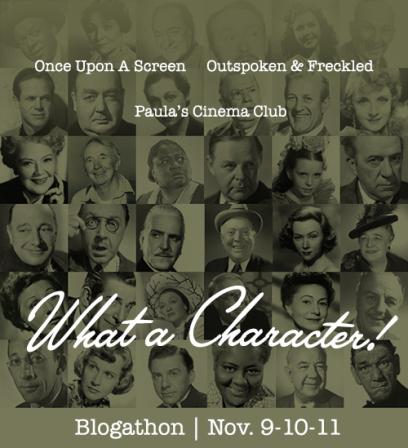 This is the SBBN entry for The What A Character! Blogathon, hosted by Once Upon a Screen, Outspoken & Freckled, and today’s host Paula at Paula’s Cinema Club. There are a ton of terrific articles spanning the three-day ‘thon, so please check them all out!
This is the SBBN entry for The What A Character! Blogathon, hosted by Once Upon a Screen, Outspoken & Freckled, and today’s host Paula at Paula’s Cinema Club. There are a ton of terrific articles spanning the three-day ‘thon, so please check them all out!
***
It’s difficult to imagine a more steadfast, hardworking, solid character actor than Regis Toomey. Cast as a policeman in more films than most actors in the Golden Age of Hollywood could list on their entire resume, Toomey worked in Hollywood and on the small screen for five decades, and had one of the most recognizable faces in the business, even if most people never knew his name.
Regis Toomey was born in Pittsburgh, Pennsylvania, in the neighborhood of Lawrenceville, in 1898. As a teen, he attended the University of Pittsburgh, pursuing a degree in history and philosophy with an eye toward a law degree, but ultimately pursued a degree in theater. He graduated from Pitt in 1921 and then enrolled in Carnegie Tech’s theater department; in Mary Ellen Stelling’s semi-fictitious memoir A Place to Call Home, she claims Regis, a family friend, “put himself through Carnegie Tech by moonlighting as a traveling salesman.” Given his father was a lawyer and the Toomey family included as their friends at least one sitting U.S. Supreme Court justice, it’s unlikely he needed to moonlight at any job at all.
After graduating, he had a successful run on stage in musical comedies. Several sources claim he made it to Broadway in the mid-1920s production of “Rose-Marie.” If you’re wondering why the IBDb doesn’t list him at all, it’s because he was only in the chorus, and though publicity later claimed he was Dennis King’s understudy, King was apparently in perfect health for the entire seven month stint in “Rose-Marie,” and Toomey stayed put in the chorus.
While touring Europe in the late 1920s, Toomey lost his singing voice, and decided to pursue straight acting, once apparently writing Thomas Meighan asking for advice; a 1930 newspaper profile on Toomey joked that Regis never received a reply, and was “still wondering whether he should have enclosed a self-addressed stamped envelope.” Soon, he got his first film role as a featured player in Alibi, one of the earliest examples of a gangster film. Alibi is one of the best examples of the handful of late silents and early talkies that, in retrospect, bear more than a passing resemblance to what became the film noir genre in the 1940s.

Picture courtesy Operator99 at Allure, where a whole host of scans from the 1930 Stars of Photoplay are posted. Highly recommended reading!
Alibi’s director, Roland West, was reluctant to cast Toomey, and was not at all happy with his performance. This tension culminated in a lengthy fight over how a drunk man should talk. Toomey, who was playing the pretend-drunk Danny in the film, later said, “[West] had some sort of screwy idea of something mechanical that had to be done with the tongue in order to sound drunk. I said, ‘Well, hell, Mr. West, the audience won’t understand what I’m talking about. This is a talking picture.’ He didn’t like my attitude. The assistant director stepped in, and he risked his job, and he said, ‘He’s right, Mr. West.’ So he sulked a little and finally that was the end of it.” [1]
Toomey’s appearance in Alibi became infamous for his lengthy and unintentionally hilarious death scene, something that Regis referenced often in interviews later on in his career. A 1941 article in the Magazine of Sigma Chi, the fraternity Toomey belonged to at university, notes that the actor found himself killed off early in films ever since his death in Alibi, “usually in the first reel.” Historian Hal Erickson expanded upon his AllMovie synopsis a couple of days ago by referring to a couple of TV Guide interviews with Toomey from the 1960s, where the actor reiterated that he simply wasn’t allowed to die too late in a movie after Alibi. “The [TV Guide] article is illustrated by a picture of the 1962 version of Toomey pointing to his 1929 self from an ALIBI still with a smirk on his face,” concludes Erickson.
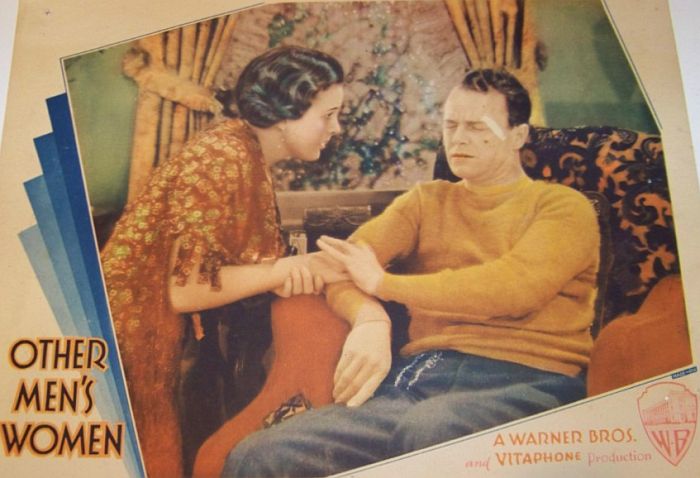 Detail of lobby card for Other Men’s Women (1931), courtesy Movie Classics.
Detail of lobby card for Other Men’s Women (1931), courtesy Movie Classics.
Still, Toomey managed to score leading man parts for the next few years, his wavy hair and boyish looks making him popular with audiences, and his acting often garnering good reviews. Variety, in their review for Framed (1930), singled him out as an “outstanding performance, matching nicely that of the heroine’s.” The New York Times also noticed Toomey favorably in Other Men’s Women (1931), though they, along with almost every other publication, admitted that supporting actors James Cagney and Joan Blondell stole the film from Toomey and his leading lady, Mary Astor.
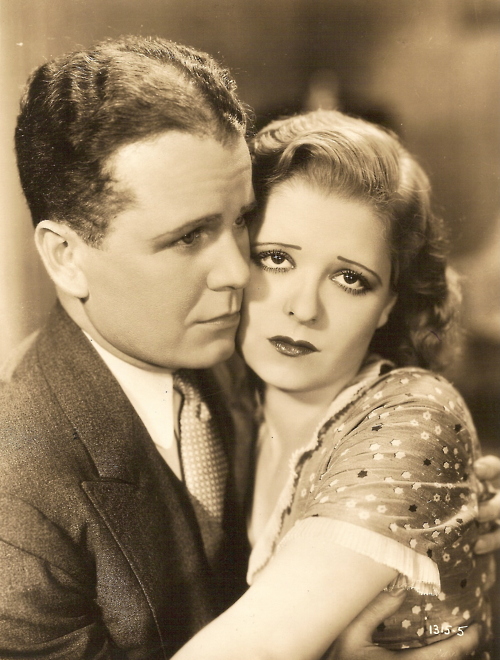 Regis Toomey and Clara Bow in Kick In (1931)
Regis Toomey and Clara Bow in Kick In (1931)
Clara Bow, made nervous by the advent of talkies in the late 1920s, was still not over her fear by the time filming began on Kick In, her last film for Paramount. Numerous scandals, a lawsuit and abusive treatment from her studio had made her a nervous wreck, and it’s likely she was suffering from an undiagnosed mental illness by 1931, as well. Her leading man in Kick In was Regis Toomey, an ex-con trying to go straight with the help of his wife, played by Clara. Regis was already on his 16th film in two years, and director Lothar Mendes felt confident enough of Toomey’s experience to turn the focus of the film onto him, in an effort to relieve Clara of some stress.
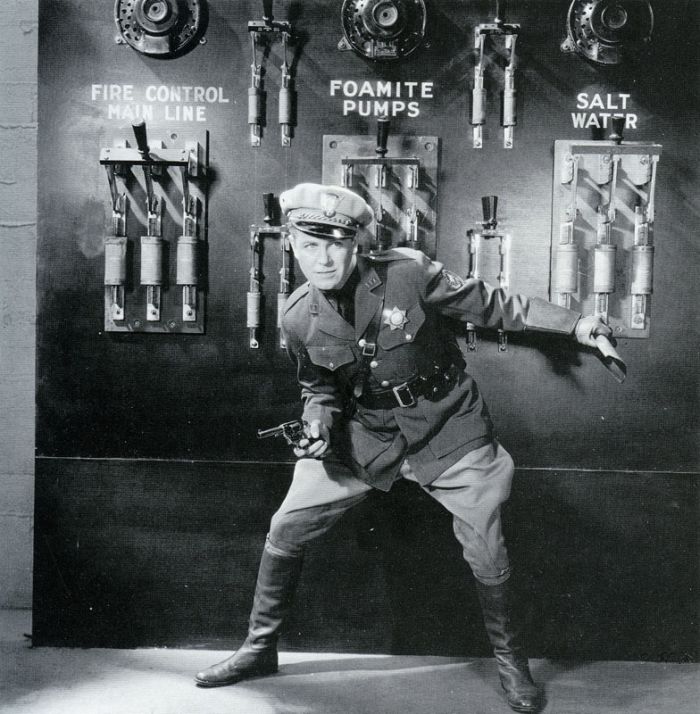 Regis being upstaged by Foamite in State Trooper (1933)
Regis being upstaged by Foamite in State Trooper (1933)
It wasn’t long after Kick In that Regis found himself in smaller supporting roles, in films such as She Had to Say Yes (1933), a scandalous pre-Code crammed full of amazing character actors; besides Toomey, Winnie Lightener, Lyle Talbot, and my personal bete noire, Hugh Herbert, co-star. My good blog friend Cliff Aliperti wrote about Hugh for the ‘thon here — you should check it out!
Besides second-lead roles in bigger budget films, Regis also scored leads in B-movie fare such as State Trooper (1933) and What’s Your Racket? (1934). By the end of the decade, however, he was finding himself in things like The Phantom Creeps (1939) and ninth billed in the forgettable (and forgotten) Indianapolis Speedway (1939).
 The John Doe Club in Meet John Doe (1941)
The John Doe Club in Meet John Doe (1941)
A small role for Regis in the 1940 hit His Girl Friday lead to what could be called bigger small parts; that is, characters that may have only had a few lines and a minimum of screen time, yet had significant impact on the plot. This type of character proved to be Toomey’s forte, and in 1941, he made a huge splash as a member of the John Doe Club in Meet John Doe. His moving monologue received an ovation at the press screener, and when one “EGF” sent a letter to screenwriter Robert Riskin suggesting that only the other “John Does” in the story could convince John (Gary Cooper) to not jump, Riskin showed the letter to director Frank Capra. The director had been struggling with the finale for some time, and at some point, Regis’ name was written on EGF’s letter, and a new finale was written to feature him leading members of the John Doe Club to tell John they never lost faith in him: “We just lost our heads,” he says of their previously reprehensible behavior. This ending, while never wholly satisfying to Capra, was a success with viewers and critics alike. After the film and its new ending went into wide release, critic John Chapman said Toomey’s soda jerk character was the “real John Doe of the picture,” not Cooper. [3]
That same year, Regis made entertainment headlines again in You’re in the Army Now (1941). Reportedly, he and co-star Jane Wyman shared a kiss lasting three minutes and five seconds, the longest kiss at the time. The logistics of such a kiss are a head-scratcher, and there is the little matter of the kiss not actually being in the film.
After a quick investigation, it seems this business about the kiss shows up in a September, 1941 AP article, distributed to papers across the country and given such headlines as “Blond Jane Wyman Sets New Film Kiss Record”. It could be nothing more than publicity for the film, a scene created specifically for the press, and the studio clearly got a lot of mileage out of it.
Still, even though this three minute kiss is not in the film, remnants of the scene remain. The AP article claims the scene consists of Douglas MacBride, Wyman’s father in the film, going on a lengthy rant while the pair kiss behind him. As the film exists now, MacBride walks in and does a double take immediately instead of going on a tear. In the version available to us — and by “available” I mean “finding someone who recorded it off TCM a while back” — the kiss is about 20 seconds long.
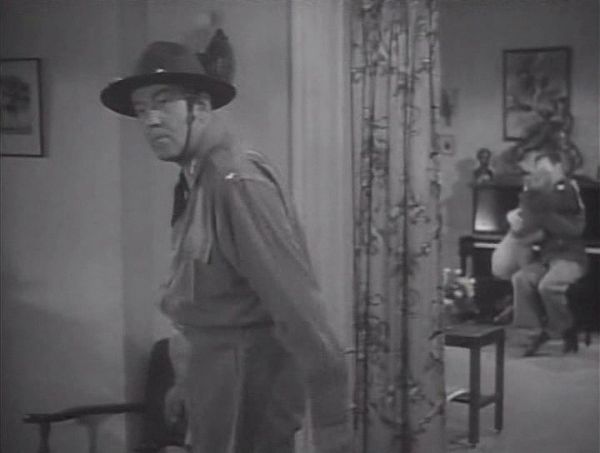 Toomey and Wyman in their not-actually-three-minutes-long kiss.
Toomey and Wyman in their not-actually-three-minutes-long kiss.
I half suspect this kiss did exist on screen at some point, and TCM showed the edited-for-television version, and here’s why: The film made the rounds in the 1960s on local stations, and was apparently quite the success on Saturday afternoons. That’s not a surprise, since even though it’s a very silly film, Phil Silvers and Jimmy Durante work impeccably together, and not only look to be having a ball, but genuine affection for each other.
Another anecdote pointing toward my edited-for-TV theory is Stelling’s semi-memoir, quoted above, where she claims her mother was astonished to see family friend Regis Toomey in a bathtub in Army. No such scene appears in the film, nor do any remnants. It’s possible that comedy naked bathtub shenanigans and inappropriate kissing time were elided to make the film more kid-friendly, and TCM, as they have done on occasion, airs the edited version without realizing it’s been edited.
Hilariously, multiple people in books and online have groused that the kiss in Army “didn’t count” because the pair were literally glued at the lips, which is wrong. Completely, utterly wrong. Even in the publicity, there is no mention of anyone being glued to each other’s lips. Apparently, people came to this conclusion by (a) not watching the damn movie, and (b) reading Kevin Dwyer’s book Kiss & Tell a bit too literally. With all this misinformation floating around, it’s impossible to know the truth without a lot more research, which I will leave for someone more dedicated than myself to unearth.
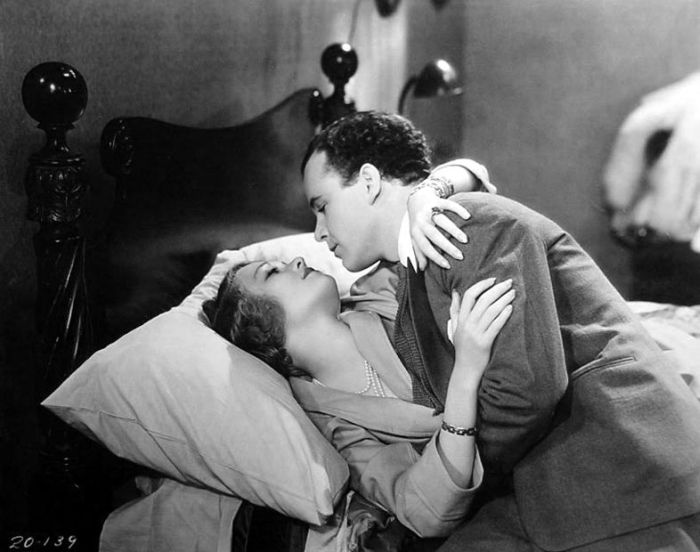 Constance Bennett and Regis Toomey in Rich People (1929), a now-lost early talkie.
Constance Bennett and Regis Toomey in Rich People (1929), a now-lost early talkie.
When Regis was interviewed in 1983, by then an 85-year-old resident of the Motion Picture Television and Country House, he was asked about this kiss with Jane Wyman. A long-time Republican and friend of Ronald Reagan since the 1930s — Reagan was married to Jane Wyman at the time — Regis told the paper he was nervous when he saw Ronnie run up to him soon after the scene was shot. With a serious look on his face, he asked Regis point blank, “How’d you ever get her to sit still for so long?”
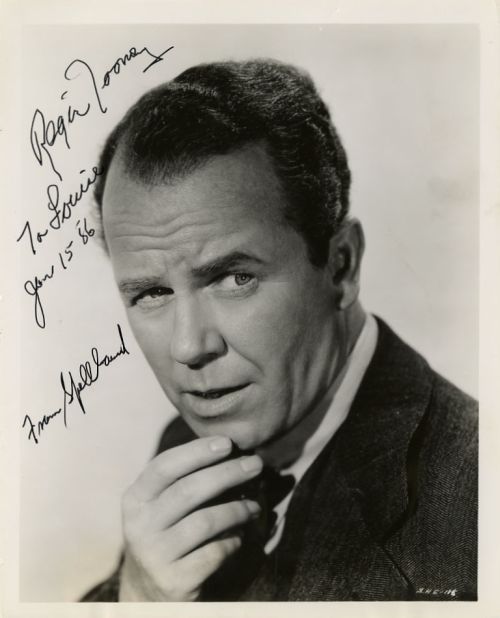 In Radie Harris’ 1930 “Stages” profile on Regis, he lists his likes as “beautiful women… Jews, and the Irish,” and dislikes as “apologetic Americans… celebrity hunters and cucumbers.”
In Radie Harris’ 1930 “Stages” profile on Regis, he lists his likes as “beautiful women… Jews, and the Irish,” and dislikes as “apologetic Americans… celebrity hunters and cucumbers.”
As the 1940s went on, Regis found himself in more and more featured parts, in films such as Spellbound (1945), The Big Sleep (1946), The Bishop’s Wife (1947), The Boy With Green Hair (1948), and Beyond the Forest (1949). (Please leave your “one of these things is not like the other” jokes at the door. Thank you. – Management)
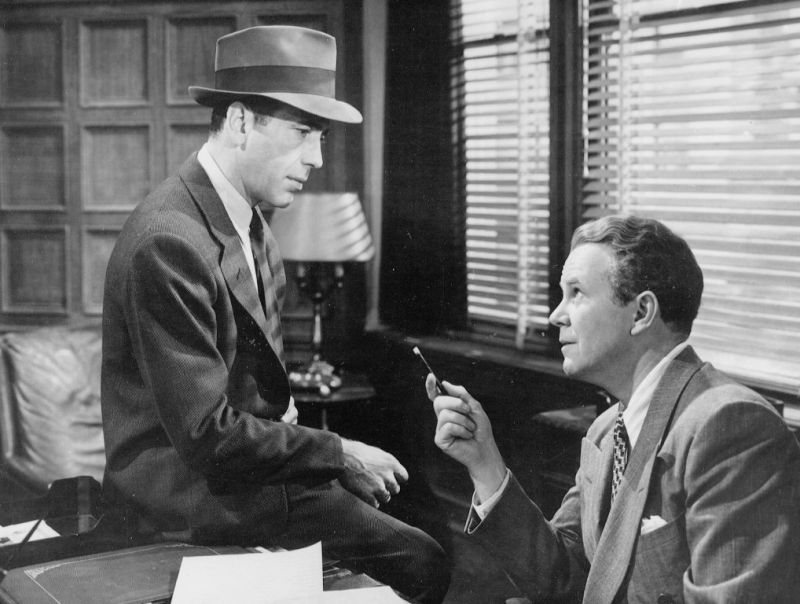 Humphrey Bogart and Regis Toomey in The Big Sleep.
Humphrey Bogart and Regis Toomey in The Big Sleep.
Starting early in the 1950s, Toomey was a fixture on television, and in 1963 was cast in a starring role in “Burke’s Law,” playing Detective Les Hart. A big hit on ABC for two seasons — it even lead to a spin-off, “Honey West” — Regis was a fan favorite, and many of his former Hollywood colleagues wound up in guest starring roles on the show. Then the third season happened, and Regis, along with everyone else save Gene Barry as Burke, was fired, and what had once been a well received murder-mystery show was turned into a campy spy caper. It, as I’m sure you have guessed, did not last even a full season.
A few guest spots and some very silly films, including Change of Habit (1969) and Won Ton Ton: The Dog Who Saved Hollywood (1976) followed. A cameo in the B-list-studded, bizarre film C.H.O.M.P.S. (1979) and a guest appearance on “Making A Living” (titled “It’s A Living” for most of its seasons, I think) in 1981 were his last roles. His wife of 56 years, who he met during his chorus days on Broadway, had passed on by then, and Toomey was well into his 80s. He retired to the Motion Picture and Television Country Home, where he lived for nearly a decade until he passed on at the age of 93.
Even amidst all the cheesy Z-grade schlock and no-budget matinee fare and tiny little roles, Regis Toomey brought a professionalism, a calm and solid presence that helped anchor even the most tenuous of productions. And despite what many considered a plain face and nondescript features, the camera loved him. You can see him even at a distance in long shots, especially in the Westerns he graduated to in the 1950s, with their extreme aspect ratios and the sharp, clear, color-coded worlds they inhabit. There is a particularly terrific example of this in a shot on the main street of Warlock (1959) where Regis is a tiny figure in the background, yet he’s recognizable, engaged, and the concern on his face registers over the entire scene.
“I’d rather be a supporting actor than a star. Supporting actors last longer,” Regis famously said in a 1950s interview. He got his wish, spending fifty years on screen in supporting roles that were often overlooked, even if they shouldn’t have been. He even expressed satisfaction with being typecast as a cop for decades, though he had one regret: “Once in a while it would have been nice if I could have gotten the girl at the end.”
Sources:
• Big thanks to Ivan G. Shreve, Jr. and Hal Erickson!
[1] The Life and Death of Thelma Todd by William Donati
[2] A Place to Call Home by Mary Ellen Stelling, Peter James Stelling
[3] Frank Capra: The Catastrophe of Success by Joseph McBride

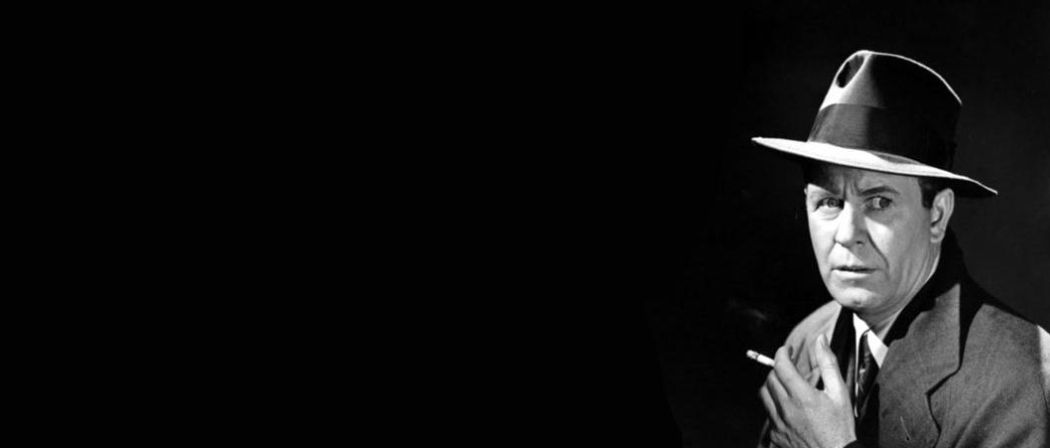
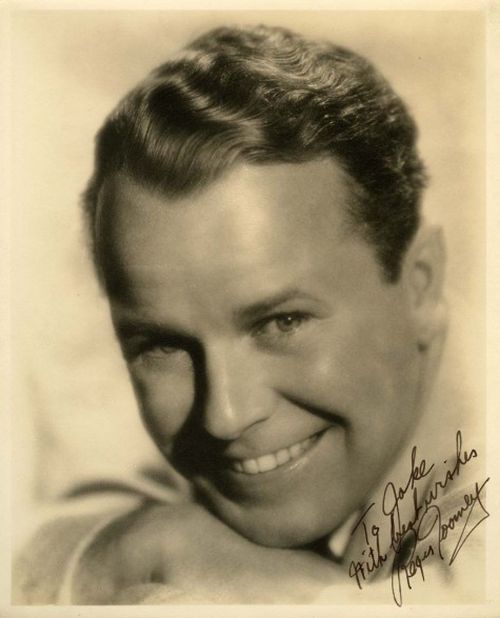
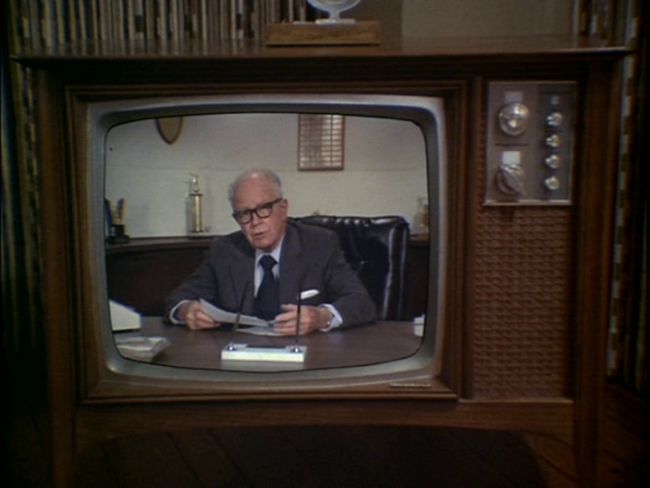
Pingback: What A Character! Monday posts | Paula's Cinema Club
I love that you can settle in for a marathon of ’30s movies and without even planning it have Regis show up in every single one of them. I know, it’s happened!
Absolutely love the State Trooper still–it’s sold me, that’s one I haven’t seen and now I’ve got to see if I have a copy!
Great early biographical stuff (always my favorite part!) with gratitude for the link. Nice to see our characters meet up in what is clearly a favorite for both of us.
Regis is EVERYWHERE! I confess I didn’t think much about him for years. He was like Wally Ford, always around, hanging out in Hitchcock movies and such, one of those guys who would end up on a TV show when I was a kid and my parents would say, “Hey, that’s Regis Toomey” — which I’m certain they said during that “It’s a Living” episode — but I really started paying attention after reading the Clara Bow bio. That’s when I realized he had been a star, lost the stardom, then got it back as a character actor all those years later. That’s awesome.
Also, in The Phantom Creeps, he’s a total badass.
Pingback: WHAT A CHARACTER! blogathon Schedule « Once upon a screen…
I’ve met a lot of Regis Toomey fans over the years, but have yet to meet anyone who doesn’t like him. Says a lot. Loved reading your piece on the epitome of the working actor.
Thanks Patricia! You’re right, everyone loves Regis, and he seemed well liked by his costars too.
Fantastic read, as all of your posts are! Loving gangster films as I do, I can’t believe I’ve never seen ALIBI!! Must correct that. Toomey is one of my favorites in most movies I see him in and am now duly fascinated by the three-minute-kiss story to boot.
Thanks so much for taking part in the ‘thon!!
Aurora
Thanks for stopping by Aurora! ALIBI is definitely dated, but it’s just so fun to look at, and I think you’ll really like it!
Yet I didn’t pay proper attention to Regis, I now recognize his face. Alibi must be a very nice film, I took note of it to watch soon. And the kiss with Jane Wyman created a wonderful anecdote!
Don’t forget to read my contribution to the blogathon! :)
Kisses!
Thanks for stopping by! I think you’ll like ALIBI, it’s a neat movie.
So I am watching Destroyer (1943) today and there he is,with EGR and a young Glenn Ford. The man is everywhere!
Hey KG! Yeah, Regis was all over the place, especially once he settled into the middle age character actor scene. He was a busy man.
I remember the Burke’s Law thing. I was in high school at the time, and even then I wondered what the network was thinking? Did Gene Barry ever have another decent role?
He really didn’t, and I think the people who got fired after the second season were the lucky ones. Though Barry was apparently one of the stars of “The Name of the Game,” so it wasn’t ALL “Love Boat” and “Charlie’s Angels” for Barry after that.